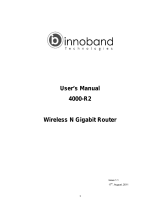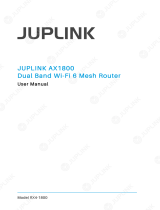
7
ProSafe Wireless-N 8-Port Gigabit VPN Firewall FVS318N
View the Wireless VPN Firewall IPSec VPN Log . . . . . . . . . . . . . . . . .221
Manage IPSec VPN Policies . . . . . . . . . . . . . . . . . . . . . . . . . . . . . . . . . .222
Manage IKE Policies. . . . . . . . . . . . . . . . . . . . . . . . . . . . . . . . . . . . . . .222
Manage VPN Policies. . . . . . . . . . . . . . . . . . . . . . . . . . . . . . . . . . . . . .230
Configure Extended Authentication (XAUTH) . . . . . . . . . . . . . . . . . . . . .238
Configure XAUTH for VPN Clients . . . . . . . . . . . . . . . . . . . . . . . . . . . .239
User Database Configuration . . . . . . . . . . . . . . . . . . . . . . . . . . . . . . . .240
RADIUS Client and Server Configuration. . . . . . . . . . . . . . . . . . . . . . .240
Assign IPv4 Addresses to Remote Users (Mode Config)
. . . . . . . . . . . . .243
Mode Config Operation. . . . . . . . . . . . . . . . . . . . . . . . . . . . . . . . . . . . .243
Configure Mode Config Operation on the Wireless VPN Firewall . . . .244
Configure the ProSafe VPN Client for Mode
Config Operation . . . . . .251
Test the Mode Config Connection . . . . . . . . . . . . . . . . . . . . . . . . . . . .258
Modify or Delete a Mode Config Record. . . .
. . . . . . . . . . . . . . . . . . . .259
Configure Keep-Alives and Dead Peer Detection . . . . . . . . . . . . . . . . . .259
Configure Keep-Alives . . . . . . . . . . . . . . . . . . . . . . . . . . . . . . . . . . . . .260
Configure Dead Peer Detection . . . . . . . . . . . . . . . . . . . . . . . . . . . . . .261
Configure NetBIOS Bridging with IPSec VPN . . . . . . . . . . . . . . . . . . . . .262
Configure the L2TP Server. . . . . . . . . . . . . . . . . . . . . . . . . . . . . . . . . . . .263
View the Active L2TP Users. . . . . . . . . . . . . . . . . . . . . . . . . . . . . . . . .265
Chapter 7 Virtual Private Networking
Using SSL Connections
SSL VPN Portal Options. . . . . . . . . . . . . . . . . . . . . . . . . . . . . . . . . . . . . .266
Overview of the SSL Configuration Process . .
. . . . . . . . . . . . . . . . . . . .267
Create the Portal Layout. . . . . . . . . . . . . . . . . . . . . . . . . . . . . . . . . . . . . .268
Configure Domains, Groups, and Users. . . . . . . . . . . . . . . . . . . . . . . . . .272
Configure Applications for Port Forwarding . . . . . . . . . . . . . . . . . . . . . . .273
Add Servers and Port Numbers . . . . . . . . . . . . . . . . . . . . . . . . . . . . . .273
Add a New Host Name. . . . . . . . . . . . . . . . . . . . . . . . . . . . . . . . . . . . .274
Configure the SSL VPN Client . . . . . . . . . . . . . . . . . . . . . . . . . . . . . . . . .275
Configure the Client IP Address Range . . . . . . . . . . . . . . . . . . . . . . . .276
Add Routes for VPN Tunnel Clients . . . . . . . . . . . . . . . . . . . . . . . . . . .278
Use Network Resource Objects to Simplify Policies
. . . . . . . . . . . . . . . .279
Add New Network Resources. . . . . . . . . . . .
. . . . . . . . . . . . . . . . . . . .279
Edit Network Resources to Specify Addresses
. . . . . . . . . . . . . . . . . .280
Configure User, Group, and Global Policies. . . . . . . . . . . . . . . . . . . . . . .282
View Policies. . . . . . . . . . . . . . . . . . . . . . . . . . . . . . . . . . . . . . . . . . . . .283
Add an IPv4 or IPv6 SSL VPN Policy. . . . . . . . . . . . . . . . . . . . . . . . . .284
Access the New SSL Portal Login Screen . . . .
. . . . . . . . . . . . . . . . . . . .288
View the SSL VPN Connection Status and SSL VPN Log. . . . . . . . . . . .292
Chapter 8 Manage Users, Authentication, and VPN Certificates
The Wireless VPN Firewall’s Authentication Process and Options . . . . .294
Configure Authentication Domains, Groups, and
Users. . . . . . . . . . . . . .296
Configure Domains. . . . . . . . . . . . . . . . . . . . . . . . . . . . . . . . . . . . . . . .296
Configure Groups . . . . . . . . . . . . . . . . . . . . . . . . . . . . . . . . . . . . . . . . .300






















